Why Understanding Motta the Player is important before understanding him as a coach
Thiago Motta as a player was one of the most elegant midfielders of the last generation. Unlike his Compatriot Andrea Pirlo who is credited as the archetype ‘Regista’, a term used to describe deep lying playmakers in Italian football, Motta was described more as a ‘Metodista’, a player that would be more focused on cleaning up defensively than be the man pulling strings from deep, but nonetheless Motta’s partnership with Marco Verratti was a treat to watch.
Like many midfielders of his time that made their way to being a coach we see today across various European leagues, it wasn’t unexpected that Thiago Motta pursued his idea of coaching the game, the way he saw it when he was the man pulling strings in midfield.
In his own writing titled “The Value of the Ball- The Instruments of exchange in the heart of Game”, he explained how the ball was an affective object and a collective instrument and why his game under Gasperini (then at Genoa), Jose Mourinho at Inter and subsequently under Carlo Ancelotti and Laurent Blanc at PSG shaped his own playing style from time to time and these elements also came into fore his coahcing setup, simultaneosuly seen under various clubs as we explore on it below.
Also read: Jadon Sancho’s Struggles Continue At Manchester United: Is His Future In Jeopardy?
Understanding Thiago Motta’s Coaching Principles in his Own Words
During an Interview in 2018 when Thiago Motta 1st began taking steps to coach, his interview with an Italian Newspaper explored some of the ideas we see today with the sides he’s coached:
“My idea is to play offensively. A short team that controls the game, high pressure and a lot of movement with and without the ball. I want the player that has the ball to always have three or four solutions and two teammates close by to help. The difficulty in football is, often to do things simply but to control the base, pass and get free. I don’t like the numbers of the field because they trick you. You can be super offensive with a 5–3–2 and defensive in a 4–3–3.”
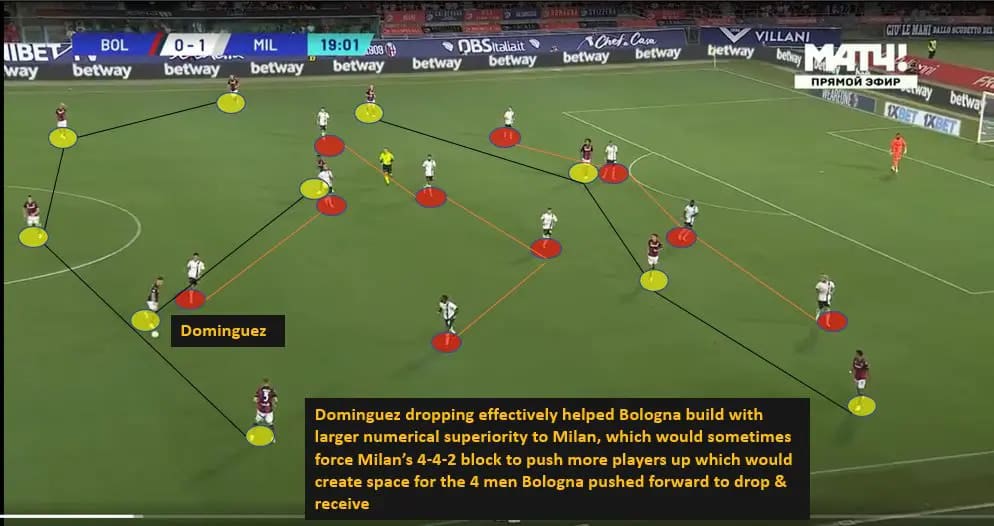
The line “I want the player that has the ball to always have three or four solutions” is the 1st important point to note. Let’s take the example of his Bologna side against Milan this season in the pic above. In order to facilitate buildup in final 3rd, Motta’s plan was to use Nicolas dominguez as a part of backline, enticing press onto him and at this situation, Dominguez has the CB and FB besides him as passing options who themsleves have pasisng option to the wingers in a 4-2-4 setup that are pinning the backline.
Here the idea translates that by having 4 players pin the backline, Milan would be forced to drop a player behind if needed, and this way, opens multiple options for Dominguez to play to, and would also not entice Milan to make too many press jumps and open spaces between lines.

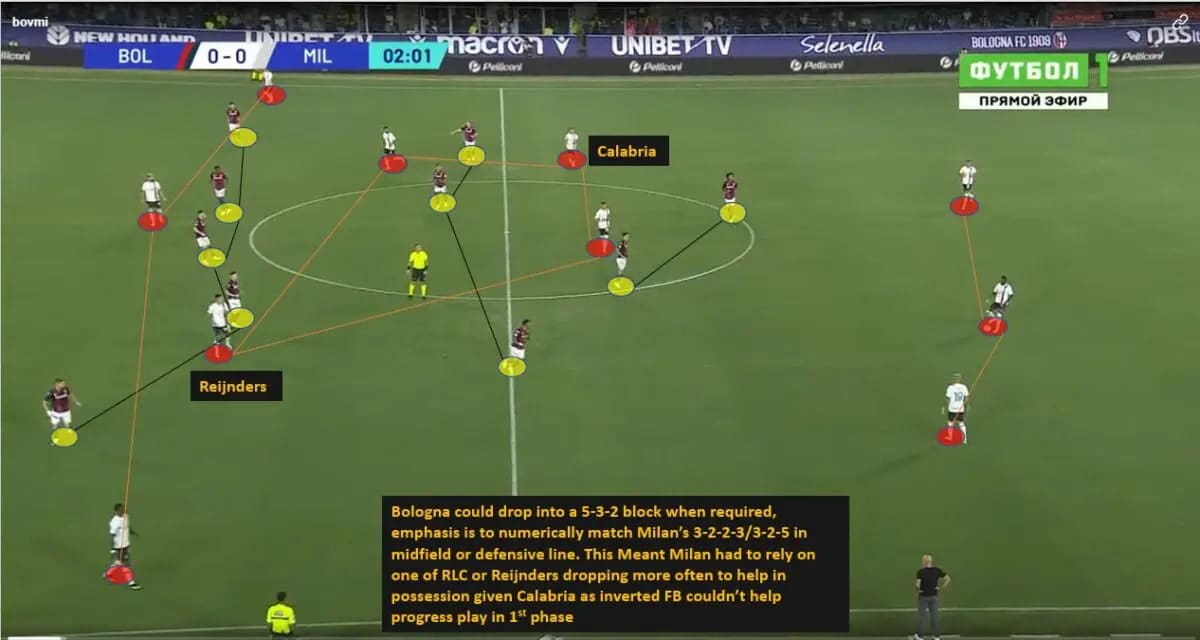

Pic 2,3 and 4: Bologna’s starting Pressing structure, settled defensive structure and their Buildup
In the same Interview Motta expanded: “Depending on the quality of the guys. I had a game a while ago where the two full-backs ended up playing as the 9 and 10. The goalkeeper counts as one of the midfield seven. For me, the attacker is the first defender and the goalkeeper is the first attacker. The goalkeeper starts the play, with his feet and the attackers are the first to put pressure to recover the ball”
The Goalkeeper is always the 1st attacker, a part of the midfield 7. Pic 4 encompasses this idea a lot, because for Motta, similar to many coaches today, Goalkeeper is vatly important in playing through a press, opening gaps between lines. The attackers are always the 1st to put pressure on the ball, which Pic 2 shows where Motta’s preference is always go man to man on opposition’s Buildup structures (here Milan building in a back 3 meant, Thiago Motta presses with a front 3).
Aslo read: Super Eagles Kick Off 2026 FIFA World Cup Qualifiers With Home Fixture Against Lesotho
And Pic 3 encompasses another line we read through in his 1st comment: “You can be super offensive with a 5–3–2 and defensive in a 4–3–3”- Pic 3 sees Bologna defend in a 5-3-2 but still this system in transitions had many opportunities to hurt milan.
Thiago Motta’s evolution as a coach: Early days at Spezia, The Bielsa influence and his 1st True Project at Bologna
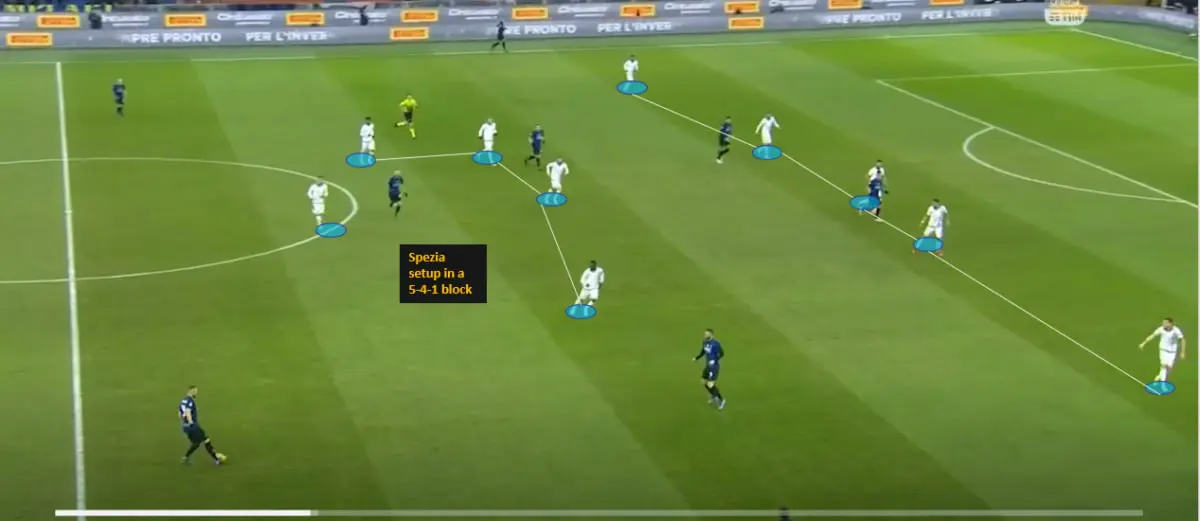
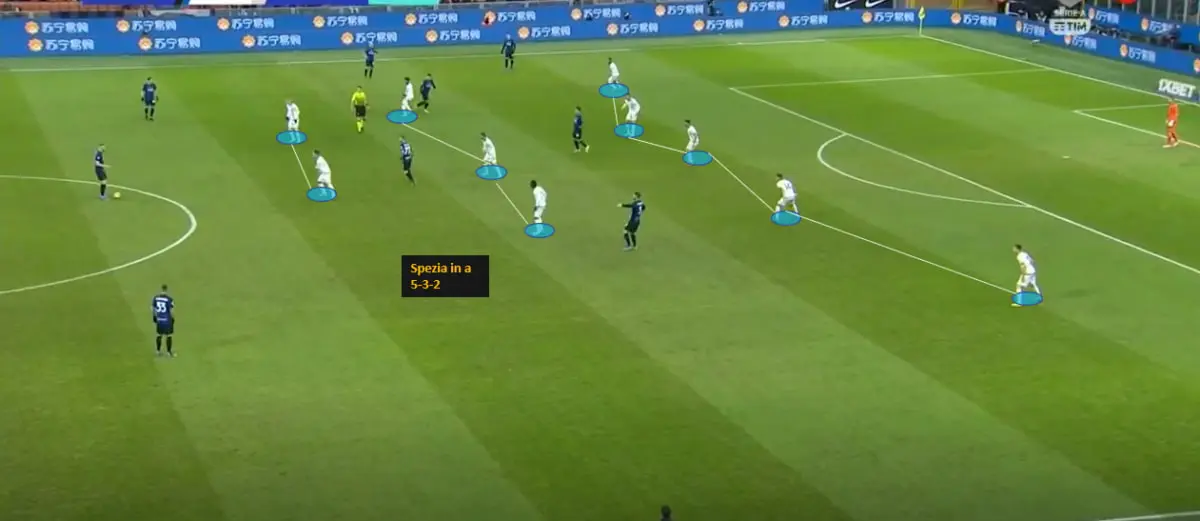
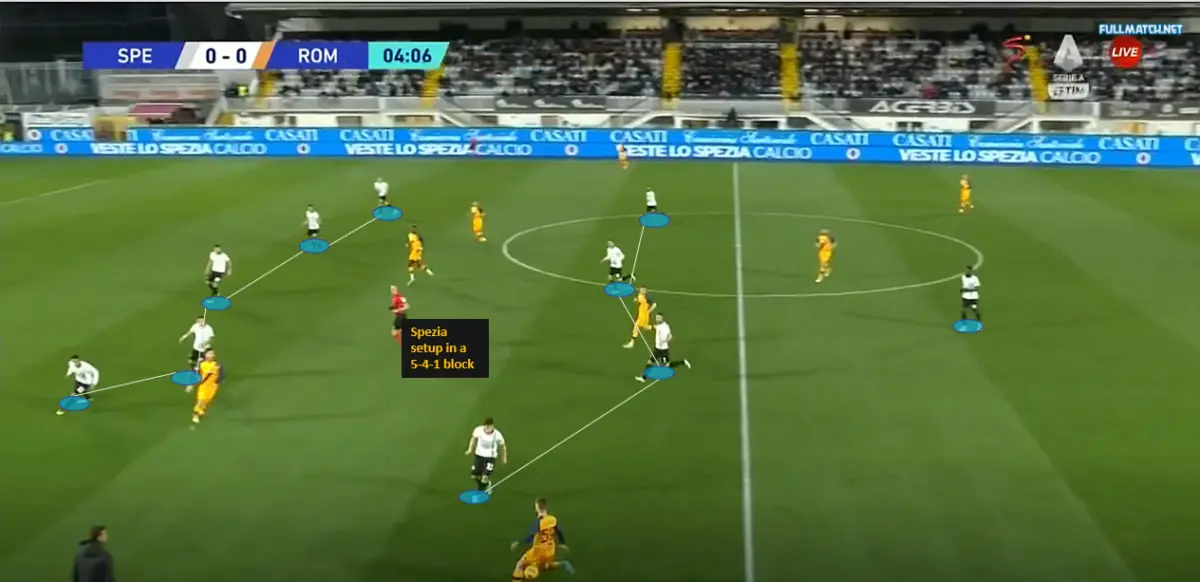
Pic 5,6,7: Spezia’s common feature under Thiago Motta was using Kiwior as a DM and featuring a 5-4-1/5-3-2 low block against most sides
As a coach, like many others, it took time for Thiago Motta to get the right Project in a club where his ideas would be supported for and invested in. Though his 1st job was in Genoa, it lasted only 2 months from October to December in 2019 and it’s futile discussing such a low sample space. But 2 years later his 1st full season job came at Spezia, where Motta made the most of his squad at disposal, a side that was called as certain relegation candidates after Vincenzo Italiano’s departure and some key players leaving for better pastures.
Also read: Five Lessons Learned From Premier League Matchday 4
One of his best works in Spezia was recognizing the technical and tactical strengths of his team and how he shaped a 20-year-old Jakub Kiwior at the heart of Spezia’s play, sowing seeds for the player’s game to develop and moving to Arsenal last January.
If we go through pic5, 6, and 7, we see how Motta’s preference for a 5-4-1 low block that focused on chance creation through transitions had them test the resolve of most teams to break them down, and this system defensively proved very useful in Spezia’s campaign to avoid relegation.
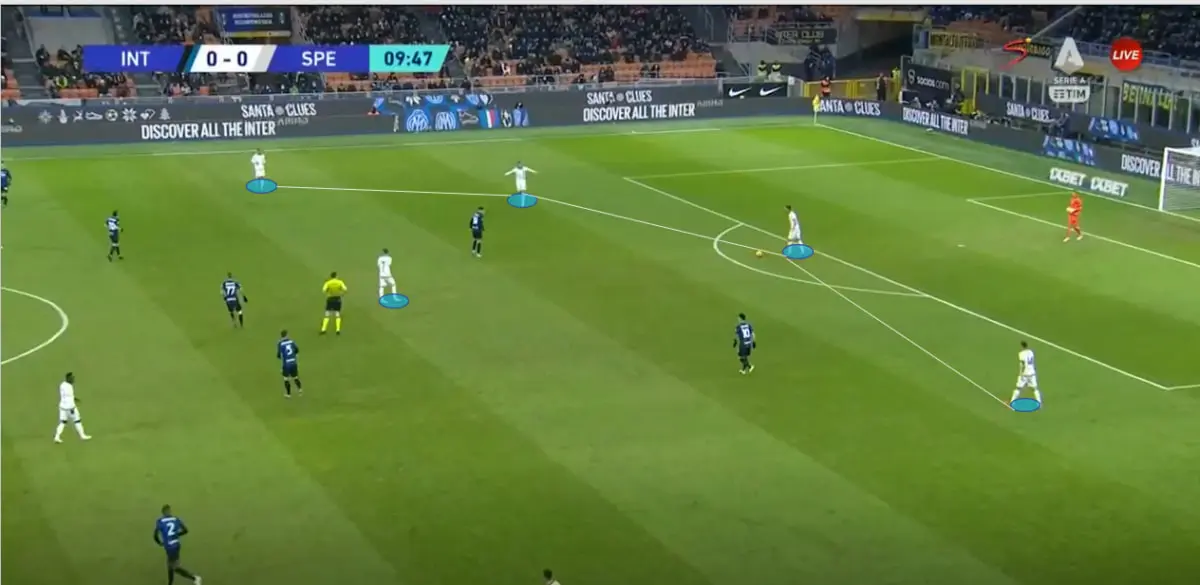


Pic 8,9,10: Spezia’s 4-1/4-2 buildup focuses on wide combinations by pushing 8’s high
Spezia’s buildup structure importantly more into 2nd half of season was the early signs of what his style would evolve into at Bologna. The usage of Kiwior as a Pivot in a 4-1/4-2 sometimes would develop Kiwior’s game a lot on ball as well as Motta’s focus on pushing 8’s high to combine with wingers and fullbacks in the wide areas. Though like mentioned before, his usage of Golakeepers in buildup would only evolve in Bologna with his focus on Spezia largely falling on avoiding relegation and showing his capability as a coach by structuring a strong defensive system and focus on Player development.
As we discuss Motta’s time at Bologna, we once again come back to his writing “The Value of the Ball- The Instruments of exchange in the heart of Game” where he described Marcelo Bielsa’s Leeds example and how that’s seen in the video above:
“it is very interesting to note how the central defender remains at the disposal of the team-mate in possession of the ball either 1) proposing himself in the space created or 2) requesting the ball to himself, and then replaying it diagonally vertically, again to use the advantage of the space created as a result of the pressing, towards the other midfielder on the opposite side.”
Here we See Bologna Center back Bekeuema do the same, replaying ball diagonally after enticing a press, back to the midfielder, who himself plays the ball back to right back Stefan Posch and thus opens space to progress.
The above discussion brings light on why Bologna is the 1st true project built on Motta’s ideas: We dont see Bologna wait for the ball like in Spezia anymore, they play more proactive football and are courageous in enticing press to progress play, completely different from his spezia days.
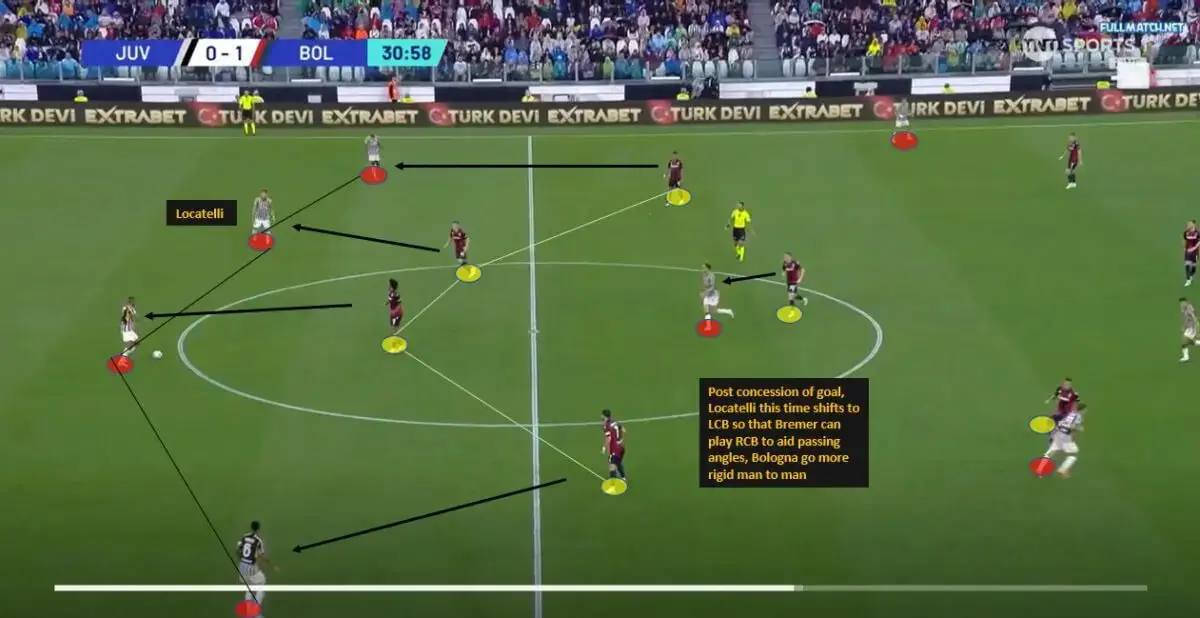
Pic 11: Another example of man to man press against opposition defence
When we discussed on Motta’s principles in his own words, we discussed in Pic 2 how Bologna pressed with a 3 man frontline ginst Milan’s 3-2 buildup. And against Juventus who built in a 4-1, they pressed with 4 men on all the backline, this is recurring trait with Motta’s sides where they constantly focus on man to man press in 1st line of press, something you can also attribute to his education from Bielsa or Gasperini. Again a symbol of evolution where he’s more confident with a squad built in his image and why Bologna’s football project is the true potential of his coaching methods.
Thiago Motta Coaching Principles & Philosophy – a Conclusion
Thiago Motta’s development as a coach isn’t linear and he isn’t any exception in this case but his work at Bologna is proving that he’s a coach who if backed properly with his vision can slowly build a process that can foster player development and subsequently lay the path for results. Motta is also in many senses has his own unique identity and cant really be associated to his peers in ideological sense and this makes his case as a coach interesting.
Also read: Super Eagles’ 2023 AFCON Qualifier Camp Delayed, Players Set To Arrive Tonight
But just like many other promising coaches, Thiago Motta needs to choose his steps carefully, understand where subsequent jobs can arise that can back his vision and rise to top of European football.


